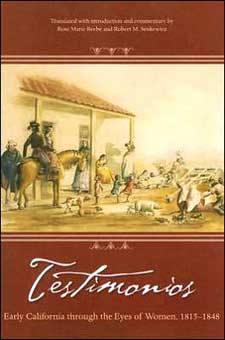
Book Review
Testimonios: Early California Through the Eyes of Women, 1815-1848
Berkeley, CA: Heyday Books, 2006
470 pages. Illustrations, appendices, notes, glossary, bibliographic references, and index
$27.50 (cloth), ISBN 1-59714-032-5; $18.95 (paper) ISBN 1-59714-033-3
These thirteen entrancing interviews procured by Herbert Howe Bancroft and his staff during the 1870s will interest casual readers, scholars, and descendents of the interviewed. In addition to introductory foundations and translated interviews, the authors of this work generously provide pertinent illustrations and informative appendices that include a chronology of early Mexican California events, two interviews in original form, and over two hundred brief biographical sketches.
From Henry Cerriti, a member of Bancroft’s staff, we learn that when Bancroft sought to write the history of early California he charged his team with obtaining original documents, and with interviewing every settler (white man) living in California prior to 1850 and all native Californians above sixty years in age (322). The conversations offered in this book provide considerable knowledge of California history, personalities, and customs during the Mexican period.
Several informants recited the battles that resulted in independence from Mexico. When the Americans took San Diego, Apolinaria Lorenzana and Felipa Osuna both resided nearby. Each knowledgably related an independent account of events. While many natives throughout Alta Californian disapproved of statehood, when asked about the change of flag from Mexican to American Maria Antonia Rodriguez generously allowed, “It is the law of nature that the poor should steal from the rich. We Californians in 1846 owned every inch of soil in this country, and our conquerors took away from us the greater part. The same thing, I suppose has happened over and over again in every conquered nation” (45-46).
Other voices further enrich understanding of events. Angustias de la Guerra said:
The taking of California was not at all to the liking of Californios, and least of all to the women. But I must confess, California was on the road to utter ruin. On the one hand, the Indians were out of control . . . . On the other hand, there was discord between the people of the north and the south. In addition, both north and south were against the Mexicans . . .” (265).
Dorotea Valdez was more direct. “. . . [I]f the Americans had not taken the country in 1846, by 1847 every Californio would have been killed in a civil war …” (40).
Since some material available in Testimonios has not been previously translated from Spanish to English, portions of these stories have not been generally available to a large audience. Catarina Avila’s account of the December 1848 robbery and murders at old Mission San Miguel, supplemented by the authors’ remarks, is perhaps the most complete first hand version ever published (83-93).
Apolinaria Lorenzana offers considerable insight into management of the Franciscan missions (163-92). Lorenzana, an orphan abandoned in infancy in Mexico City, was transported to Spanish California when she was seven. She lived first with a chaperone who accompanied her, then with an assigned family, and as an adult she was placed with a newlywed couple. When she became ill she was taken in by missionary Fathers. Upon recovery she became occupied with administrative tasks and also taught girls to read and sew. When the missions were secularized she continued to devote herself to serving an impoverished clergy who expressed gratitude by granting mission lands to her. These lands were taken from her through a series of legal actions which Apolinaria Lorenzana did not appear to understand. As a result, during the final years of her life she depended upon the charity of friends.
Isidoro Filomena of the Churucto tribe was the widow of Chief Solano. Her husband was allied with Mariano Guadalupe Vallejo in campaigns against various northern California Indians. In a stunt designed to intimidate Mexican authorities Vallejo was accompanied to Monterey by Solano during the 1840s. Dorotea Valdez who was in Monterey at the time of the Solano visit and all others who mentioned the incident remarked unfavorably (36-37).
Throughout this book readers will encounter knowledge they have not found elsewhere. The words of many interviewees are refreshingly straightforward. Furthermore, because the authors are talented translators who also provide contextual background and reflect upon how Bancroft’s interviewers may have mediated the words they transcribed, it is difficult to find fault with this book.

